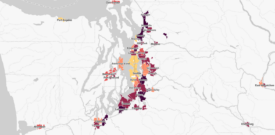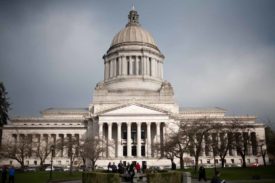On climate, jobs, fairness, and the other dimensions of sustainability, three dates in the next six months are key. Decisions made on these days will determine the pace of progress across a broad array of issues in Cascadia.
November 6, 2012
One is obvious:, the US general election. At the federal, state, and local levels, much is at stake, and if you’re the kind of person who is reading my words, you probably know all about it already.
But the other two dates may matter even more in the long term, and you may know little about them: September 25 and January 3.
November 6 will determine who wins the game this time; the other two dates may determine how the game is played, possibly for decades. Will the democratic principle of majority rule continue to erode? Or will we break the veto power currently held by minority factions and restore government by majority? Almost every issue and policy outcome you care about will likely be influenced by these other dates, if you live Cascadia.
September 25, 2012
On this day the Washington State Supreme Court will hear arguments about the state’s supermajority rule—a two-thirds filibuster rule in each house of the legislature concerning new revenue and closing tax loopholes. Three times before, the court has ducked the question on procedural grounds. Odds are better this time that the court will rule on the merits (and better than I guessed the last time I wrote about this issue). If the justices do, they will almost certainly uphold a lower-court ruling that threw out supermajority voting. The state constitution is clear and unequivocal on the question, as further demonstrated recently by a young attorney who read the minutes of the state constitutional convention.
If the Washington legislature is finally returned to majority rule, many things will become possible. Some of them are much in the news, such as adequate funding for public education, as required by recent state supreme court decisions. Other, less-known reforms would also enter the realm of possibility: an oil fee to support Puget Sound clean-up, perhaps even a revenue-neutral carbon tax shift as in British Columbia or a cap-and-trade system as in California.
OK, you’re right. I’m using September 25th as a proxy for a later date, probably in the winter, when the court will announce its decision. Still, September 25th will be a first chance to read the faces of the justices concerning the case, so it may hint at what that later date will reveal. And that date may set the boundaries for what’s possible in the years ahead.
January 3, 2013
On this day, the 113th Congress will convene in Washington, DC, and the Senate will have its best chance in the next two years to reform the filibuster. It may release itself from the perpetual gridlock and dysfunction the body’s name has become synonymous with. If Senate Democrats retain the majority and President Obama is reelected, Senate Majority Leader Harry Reid says he will tame the filibuster, employing the “constitutional option” if necessary.
The constitutional option is a method of revising senate rules by simple majority at the beginning of a new Congress. No senate has yet used it, but it has an impeccable legal history and justification. (See, for example, these two law review articles.) If Republicans take control of the Senate, they might do the same thing.
A US Senate that runs on majority rule, as the founders intended, would open up many possibilities: reforms to climate and energy policy would have a real chance, for example, as would other changes toward sustainability, like an overhaul of farm policy. Of course, a majority-rule Senate would still have to agree with the House. That might not happen right away, in today’s bitter polarization. But over the years ahead, few single reforms would do more to repair American democracy—and the climate, environment, communities, and opportunity for all—than taming the filibuster. For example, filibuster reform is almost certainly a prerequisite to restraining the influence of money in politics, arguably the biggest failing of US democracy. (On these points, Norm Ornstein and Thomas Mann are particularly cogent.)
In just the last three months, a filibuster-less Senate would have passed a law to train veterans for work as firefighters, police officers, and paramedics; a tax incentive for companies to in-source jobs, bringing them from overseas into the United States; and the DISCLOSE act, which would have patched some of the holes in federal campaign finance rules torn open by the US Supreme Court’s Citizens United decision. All three passed by lopsided majorities but fell short of the 60-vote mark that current Senate rules make necessary.
November 6th is forefront of many people’s minds, but September 25 (and its sequel) and January 3 may matter even more over the years ahead. November 6 will reveal this year’s winners; the other dates will tell us if we get back majority rule.











TacomaThawts
Ironic that the founding fathers wanted to completely get away from “the power of one” (i.e., the monarchy). And yet, democracy seems to function best when “just one vote” tips the balance…
Is that a correct interpretation of “simple majority”? Or, does simple majority mean “more than +1” in the Senate in order to get the status quo moving forward (or backward, as the case may be)?
Eric Hirst
Nice post, Alan. Kudos to the state League of Women Voters for their work to file today’s court challenge, and to attorney David Perez from Perkins Coie for doing the history homework on supermajorities in Washington.
Michelle Parker
I think it’s cool that the ORIGINAL framers of Washington state’s constitution had ALREADY debated the consequences of supermajority voting.
From Danny Westneat’s interview with David Perez:
“The phrase ‘unless a majority’ won. But only after the framers had considered, and rejected, a series of higher vote thresholds, including two-thirds, which some delegates argued was ‘prohibitory’ — that is, too high a bar.
“Bottom line: The phrase ‘unless a majority’ obviously didn’t mean a flexible standard that could include a two-thirds requirement, à la Eyman, because the framers had rejected that very thing.
“‘They were very precise about what they meant,'” Perez says. “‘And intense. They debated voting limits more than any other issue.'”
Michelle Parker
hmmm…don’t know why the “interview” hyperlink didn’t go through, above…but anyway, here it is again:
http://seattletimes.com/html/dannywestneat/2019234954_danny23.html
Alan Durning
I just watched the oral arguments before the state supreme court. It was hotly argued; clearly, the justices take the issue very seriously.
Not enough of the justices displayed their leanings to celebrate or mourn, at least to my eyes. But I could certainly see what looked like four votes to throw out the supermajority vote requirement, along with at least two leaning the other way. The silent justices, such as Steve Gonzalez, didn’t reveal anything today. But I’m still hopeful. I think there’s at least a 50 percent chance the court will take a step to restore majority rule.
Alan Durning
In case anyone wants to watch the oral arguments, you can find the video here:
http://www.tvw.org/index.php?option=com_tvwplayer&eventID=2012090015D
More soon, if I can find the time.
TacomaThawts
Would love to hear your comments! In fact, was glad you and Sightline started addressing this issue again, after a seemingly long absence. Your thoughtful insights are always so educating and greatly appreciated!
Thanks!